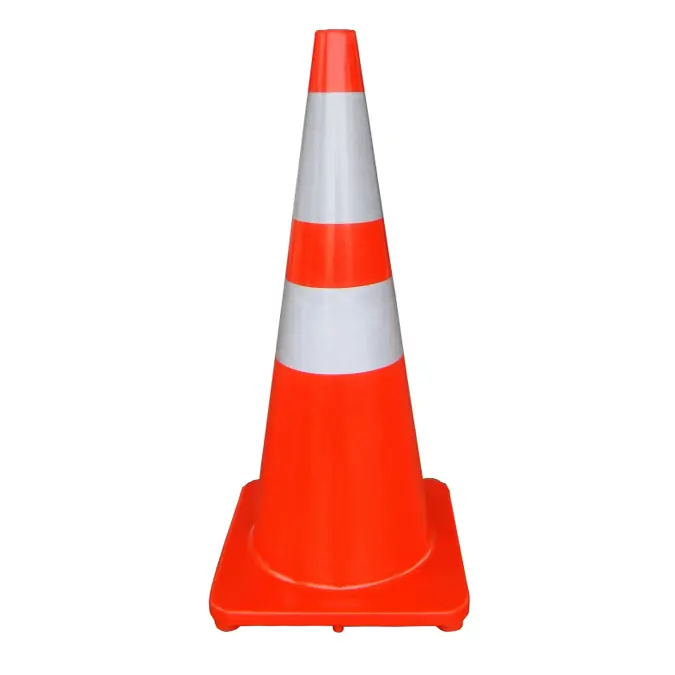Traffic cones are designed to be highly visible to drivers, particularly in low-light conditions, to enhance safety on roads and construction sites. Here are several design features that contribute to their visibility:
- Bright Colors: Traffic cones are typically fluorescent orange, which is highly conspicuous during the day. The bright color stands out against the backdrop of the road or construction site, making the cones more visible.
- Reflective Bands: Many traffic cones are equipped with reflective bands or sleeves. These bands are usually made of retroreflective materials that bounce light back towards its source, such as vehicle headlights. This makes the cones highly visible at night when illuminated by vehicle lights.
- Tapered Shape: Traffic cones are cone-shaped, with a wider base and a pointed top. This shape enhances visibility from various angles and allows them to stand stably, even in windy conditions.
- Height: Traffic cones come in various heights, with taller cones being more visible from a distance. Taller cones are often used on highways and high-speed roads, while shorter ones may be suitable for slower traffic or construction sites.
- Day-Glow Materials: The bright color of traffic cones is often achieved with day-glow or fluorescent materials that are highly visible even in overcast conditions.
- UV Stabilization: Traffic cones are designed to resist UV degradation. This ensures that the color remains vibrant over time, even when exposed to sunlight.
- Sturdy Base: The wide and heavy base of traffic cones provides stability and prevents them from being easily knocked over by wind or passing vehicles. Some cones have a rubber base to improve grip on the road surface.
- Reflective Collars: In addition to the reflective bands, some traffic cones have reflective collars that encircle the cone at various heights, further increasing their visibility.
- Illumination: In some cases, traffic cones may have integrated LED lights or beacons to make them even more visible at night. These lights can be set to flash or remain steady.
- Weather Resistance: Traffic cones are designed to withstand various weather conditions, including rain, snow, and extreme temperatures, to ensure they remain visible and functional in adverse conditions.
These design elements work in combination to make traffic cones highly visible both during the day and at night, ensuring that they effectively convey warnings and instructions to drivers and pedestrians and contribute to overall road safety.
What are the safety benefits of using reflective tape or sleeves on traffic cones?
Using reflective tape or sleeves on traffic cones offers several safety benefits, enhancing their visibility and effectiveness in various situations:
- Increased Nighttime Visibility: Reflective tape or sleeves on traffic cones make them highly visible at night. When illuminated by vehicle headlights, the retroreflective properties of the material ensure that light is directed back toward the source, making the cones stand out in the dark.
- Enhanced Low-Light Visibility: Reflective materials are also effective in low-light conditions, such as dawn, dusk, or during overcast weather. traffic cone manufacturer This extended visibility reduces the chances of accidents in less-than-ideal lighting.
- Improved Visibility in Inclement Weather: In rainy, foggy, or misty conditions, reflective tape and sleeves help maintain the visibility of traffic cones. They can be crucial in ensuring that roadwork or construction sites remain safe during adverse weather.
- Greater Recognition from a Distance: Reflective materials on cones make them visible from a distance, allowing drivers to recognize traffic control measures well in advance. This early recognition provides more time for drivers to adjust their speed and navigate safely.
- Effective Lane Guidance: Reflective sleeves on cones can be arranged in specific patterns or configurations to guide traffic through lane changes, merges, and construction zones. This ensures that drivers follow the correct path, reducing the risk of accidents.
- Traffic Organization and Direction: Reflective tape or sleeves can be used to create arrow symbols, words, or other directional indicators on the cones. This helps communicate essential information to drivers and pedestrians, such as detours, lane closures, or upcoming turns.
- Enhanced Pedestrian Safety: Reflective cones are not only crucial for the safety of drivers but also for pedestrians. They make pedestrians aware of hazards and help ensure that they stay clear of construction or work areas.
- Reduced Speeding: The improved visibility of reflective cones can encourage drivers to reduce their speed when approaching work zones, intersections, or areas with potential hazards.
- Reduced Confusion: Reflective tape or sleeves on traffic cones help reduce confusion among drivers by clearly marking areas that require caution, lane closures, or diversions. This clarity is essential for safety in complex traffic situations.
- Minimized Collisions: Enhanced visibility of traffic cones reduces the risk of vehicles colliding with them, which can lead to accidents and traffic disruptions. Fewer collisions mean safer roads and fewer delays.
Overall, the safety benefits of using reflective tape or sleeves on traffic cones are clear. They play a vital role in ensuring that work zones, road construction areas, and temporary traffic control situations are as safe as possible for both drivers and road workers.
